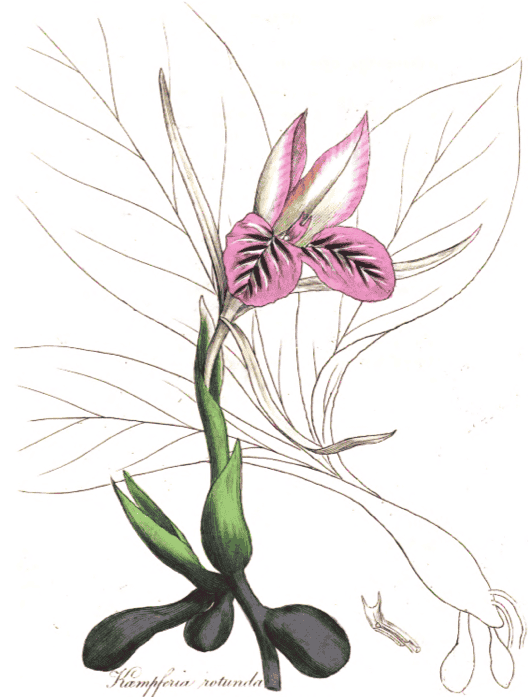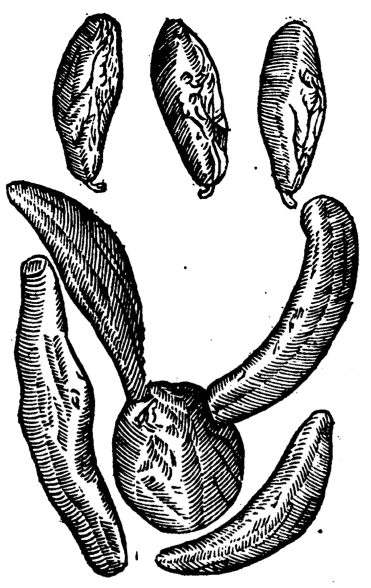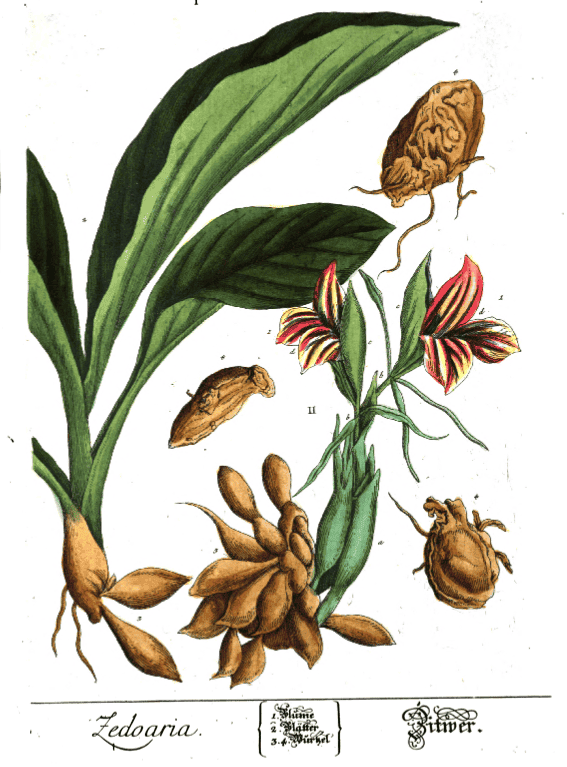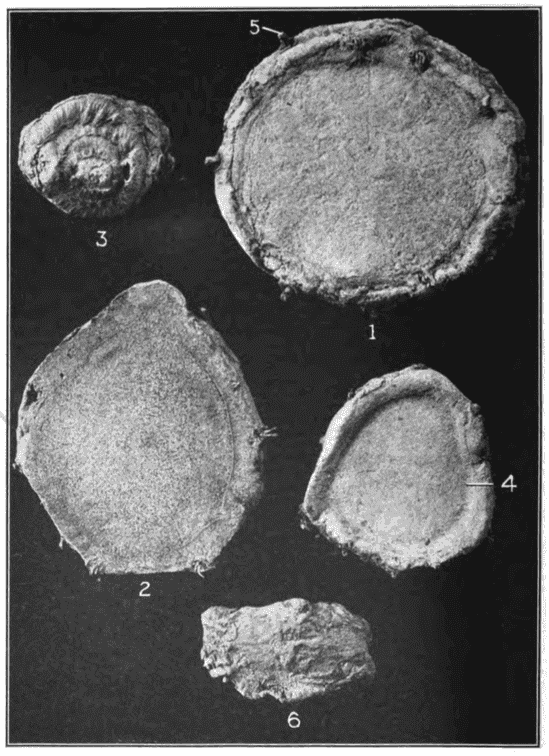Zedoaria, Zedoary, E Zhu 莪术E Zhu (TCM)Karchura (Ayurveda) Kachuri (Unani) |

|

|

|

Above: Long and Round Zedoary Parkinson, Theatrum Botanicum, 1640 Left: Medical Botany, Woodville, Hooker, 1832 |
 Herbarium Blackwellianum, 1757
Herbarium Blackwellianum, 1757 ZEDOARY
ZEDOARY1, Large transverse section of the rhizome. 2. Longitudinal section of the rhizome. 3. Top of the rhizome
showing concentric leaf scars. 4. Cross-section showing sunken tissue inside endodermis.
5. Projecting woody conducting strands. 6. Wrinkled outer surface of the rhizome.
Squibb’s Atlas of the Official Drugs, Mansfield, 1919
 Members CLICK HERE for the PRO VERSION
Members CLICK HERE for the PRO VERSIONBotanical name:
Curcuma zedoaria. C. aromatica is the Round Zedoary (syn. Kaempferia rotunda, Zedoaria rotunda)
Parts used:
Root
Temperature & Taste:
Warm, dry. Bitter, pungent
Classifications:
2A APERIENT. 2D ATTENUATERS OF CONGEALED BLOOD
3C. ALEXIPHARMIC. 3D. CORDIALS & CARDIACS. 3G. EMMENAGOGUE
4c. CARDIAC. 4e. STOMACHIC
Uses
1. Moves the Blood, Promotes Menstruation, Eases Pain:
-Dysmenorrhea, Amenorrhea.
-abdominal pain from masses associated with congealed or stagnant blood, and for Hysteria.
2. Moves the Qi, Opens Obstructions:
-chest and abdominal pain from food stagnation, or sluggish digestion
-colic, griping, dyspepsia, as well as vomiting and fluxes.
3. Moves the Blood, Resolves Masses:
-recognised as an important medicine for Tumors and Cancer in TCM, including Cancers of the Uterus, Lung, and Liver
–Gerard also lists it for ‘abscesses of the Womb’.
4. Resists Poison:
-bites of venomous beasts, as well as ‘the Plague and all Malignant Diseases’ (Salmon)
-regularly used in Antidotes
5. Clears Phlegm, Stops Cough:
-‘Cleanses the Lungs’ (Salmon)
-the Extract or Distilled Oil from the root was used as a Pectoral, and given for Coughs and Asthma
6. Externally:
-In India it is highly esteemed for application to fresh Wounds.
-mixed with Alum and made into a paste, it is applied to Bruises.
Dose:
DECOCTION: 3–9 grams
POWDER: 300mg–2 grams, with wine
Preparation:
… available in PRO version
Correctives:
… available in PRO version
Substitute:
… available in PRO version

Main Combinations:
1. Nausea and Vomiting, Zedoary … available in PRO version
2. To strengthen the Head, Stomach and Heart, Zedoary with … available in PRO version
3. To benefit Memory, increase Circulation, Dizziness, diseases of the Heart and for all Swellings, Zedoary with … available in PRO version
4. Paralysis, Zedoary with … available in PRO version
5. To promote Happiness and resist Melancholy, Zedoary with … available in PRO version
6. Loss of Appetite, Zedoary with … available in PRO version
7. Obesity, Zedoary with … available in PRO version
8. To promote Sweat, Zedoary with … available in PRO version
9. Preservative against infection during Epidemics:
i. Zedoary with … available in PRO version
ii. Zedoary with … available in PRO version
10. Postpartum Fever, Zedoary with … available in PRO version
11. Fever, Coughs and Colds, Zedoary with … available in PRO version
Major Formulas:
New Rose Powder (Rosata Novella) (Nicolas)
Aromatic Clove Powder (Aromaticum Caryophyllatum) (Mesue)
Powder of Musk Sweet (Diamoschu Dulce) (Mesue)
Powder of Happiness (Letificans)
Powder Against Obesity
Powder for Loss of Appetite Greater
Special Powder for Memory
Triphera Greater (Nicholas)
Pills for Pestilence
Cautions:
Not used during Pregnancy
Main Preparations used:
Candied Zedoary (as Ginger), Confection of Zedoary, Extract, Distilled Oil
History
|
‘This plant is the Sati and Krachura of Sanskrit writers, and the Zerumbad and Uruk-el-kdfur, “camphor root,” of the Arabians. It is noticed by the later Greek physicians under the name [?], a corruption of the Arabic name, which, in the Middle Ages, was variously written as Zeruban, Zerumber, and Zerumbet. It is not the [?] of Aetius (A. D. 540— 550) or the [?] of Myrepsus, or the Zedoar of Macer Floridus (A.D. 1140). Barbosa (1516) speaks of Zedoaria and Zeruban as distinct articles of trade at Cannanore, so that it must have been some time after this date that Zerumbet came into use in Europe as a cheap substitute for the Zedoar of the earlier physicians, which, we have no doubt, was the same drug as the Jadwar of the Arabians. This name, correctly written by Aetius, is the Zhedwar of the ancient Persians, and is described in the Burhan (A. D. 1046) as a drug used as an antidote to poisons, the same as the Jadwar of the Arabians, and also called Mahparvin. Ibn Sina of Bokhara, who lived about the same time (980— 1037), describes Jadwar shortly in the following words:– “it has the form of the root of Aristolochia, but is smaller.” Haji-Zein-el-attar, the well-known Persian physician and apothecary, and the author of the “Ikhtiarat” (A. D. 1368), describes Jadwar as a root about the size and shape of the Indian Cyperus root, but harder and heavier, and the same as the Indian drug Nirbisi, the best internally of a purplish tint. He states that there are, as far as his experience goes, four drugs sold as Jadwar, viz., a white kind, a purplish, a black and a yellow ; the people of Cathay call the yellow kind Kurti and the purplish Burbi, the other two kinds come from India. As to the locality in which the drug is collected, he states that there is a mountain called Farajal between India and Cathay, where the plant grows along with the aconite, and that the latter, whenever it grows near the Jadwar, loses its poisonous properties and is eaten with impunity by the inhabitants. Where the Jadwar does not grow, the aconite (Bish) is a deadly poison, and is called Halahal by the natives (Halahala, Sanskrit). In the Dict. Econ. Prod, of India (ii.,p. 656), the following interesting account of certain drugs collected in Nepal by Dr. Gimlette, the Residency Surgeon, substantially confirms Haji-Zein’s description of Jadwar or Nirbisi :— According to Dr. Gimlette, “the Kala bikh of the Nepalese (the Dulingi of the Bhoteas) is a very poisonous form of Aconitum ferox, so poisonous, indeed, that the Katmandu druggists will not admit they possess any. Pahlo (yellow) bikh is a less poisonous form of the same plant, known to the Bhoteas as Holingi, while Setho (white) bikh (the Nirbisi sen of the Bhoteas) is A. Napellus, and Atis is Aconitum heterophyllum. The aconite adulterants or plants used for similar purposes are, Cynanthm lobatus, the true Nirbisi of Nepal, the root of which is boiled in oil, thus forming a liniment which is employed in chronic rheumatism, Delphinium denudatum, the Nilo (blue or purplish) bikh of the Nepalese and the Nirbisi of the Bhoteas, Dr. Gimlette says, is used by the Baids of Nepal for the same purposes as the Setho and Pahlo bikh. Geranium collinum (var-Donianum) is the Ratho (red) bikh of the Nepalese, and the Nirbki-num of the Bhoteas, and, like the Setho bikh, is given as a tonic in dyspepsia, fevers, and asthma. Lastly,a plant never before recorded as used medicinally, namely, Caragana crassicaulis, is known as the Artiras of the Nepalese, and the Kurti of the Bhoteas; it affords a root which is employed as a febrifuge.” |
The Jadwar or Nirbisi myth appears to have been invented in the East to account for the curious occurrence on the Himalayas of poisonous and non-poisonous aconites growing side by side (see Vol. I., pp. 1, 15, 18, 20). It would appear also that the Curcumas have no claim to the name of zedoary, which was probably first given to them about the middle of the 16th century, as Clusius’s figure of Gedwar is certainly meant for the pendulous tuber of a Curcuma. The substitution of the cheaper for the more expensive article is rendered highly probable by the fact that Zerumbet was considered by the Arabians to be very little inferior to Jadwar as an antidote to poisons. Ibn Sina, Ibn Baitar, and Ibu Jazla in the Minhaj use almost the same words in speaking of these drugs; of Jadwar they say :— “it is an antidote for all poisons, even those of aconite and the viper”; and of Zerumbet —”it is most useful against the bites of venomous animals, and is almost equal to Jadwar.” Both drugs were considered to have properties similar to Darunaj (see Vol.II., p. 292). Ainslie (Mat. Ind., i, 492) remarks that C. Zedoaria is the Lampooyang of the Javanese, and the Lampuium of Rumphius (Herb. Amb, V., p. 148), and that it is a native of the East Indies, Cochin-Chiua, and Otaheite. He quotes Geoffrey’s description of the drug, which leaves no doubt as to its identity with the modern Kachora—”Foris cinerca, intus Candida; sapore acri-amaricante aromatico; odoro tenui fragrante, ac valde aromaticum suavitatem, cum tunditur aut manducatur, spirante et ad camphoram aliquatenus accedente.” Guibourt states that C. Zedoaria is the Zerumbet of Serapion, Pomet, and Lomery. The following is his description of it:— “The round zedoary is greyish-white externally heavy, compact, grey and often horny internally, having a bitter and strongly camphoraceous taste, like that of the long zedoary, which it also resembles in odour. The odour of both drugs is analogous with that of ginger, but weaker unless the rhizome be powdered, when it develops a powerful aromatic odour, similar to that of cardamoms.” (Hist. Nat. 6me-Ed., Vol. II., p.213.) In our opinion there is no doubt that G. Zedoaria is the source of the round and long zedoary of commerce. The plant is common in Bombay gardens, and was probably introduced by the Portuguese, whoso descendants and converts at the present day use the leaves in cookery, especially with fish. From Dr. Hove’s account of Bombayin 1787 it appears that Kachura and Turmeric were cultivated at that time in the cocoanut woods at Malum. The natives chew the root to correct a sticky taste in the mouth; it is also an ingredient in some of the strengthening conserves which are taken by women to remove weakness after child-birth. In colds it is given in decoction with long-pepper, cinnamon and honey, and the pounded root is applied as a paste to the body. Bheede says that the starch of the zedoary is much esteemed, and that the fresh root is considered to be cooling and diuretic, it checks leucorrheal and gonorrheal discharges and purifies the blood. The juice of the leaves is given in dropsy. One of us has had the plant in cultivation for some years; it blossoms in the hot weather just before the ruins, when the first leaves begin to appear. (Pharmacographia Indica, Dymock, 1893) |
